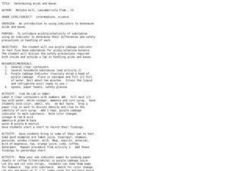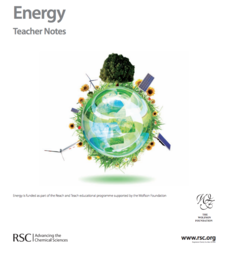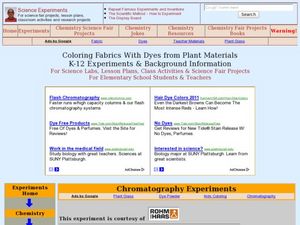Columbus City Schools
ABC: Acid Base Chemistry
Bubble, bubble, boil and trouble! What causes common substances like baking soda and vinegar to react the way they do? Welcome your junior chemists to the wonders of acid-base chemistry using a comprehensive and fun resource. Engage them...
Curated OER
Acids and Alkalis
This PowerPoint progresses slide-by-slide through all the facts you would want to deliver about acids, alkalis, salts, and the related lab tests. Each slide has one or two facts about a physical or chemical property or behavior. The...
Virginia Department of Education
Acid-Base Theory
Litmus paper, why so blue? A chemistry activity includes a pre-lab activity, practice calculating pH, an experiment measuring the pH in acids and bases, a titration demonstration, and a titration experiment.
Curated OER
Determining Acids and Bases
Students test various liquids and identify as acids or bases. In this chemistry and pH lesson, the students use purple cabbage indicator to test a variety of teacher-provided substances, then bring in liquids from home to test acidity....
Learning Games Lab
The pH Scale and Meter Calibration
What are the different ways to test for pH? First, scholars explore the pH scale and a common way to test for acidity and alkalinity. Then, they learn about the importance of pH in food safety and why variance in pH could potentially...
LABScI
Acids and Bases: Cabbage Juice pH Indicator
Explore the range of pH using an assortment of household liquids. Scholars create their own pH indicators from cabbage and determine the pH of several liquids. To further their exploration, individuals use the same liquids to create...
Royal Society of Chemistry
Some Reactions of Carbon Dioxide—Microscale Chemistry
Precipitation reactions are always interesting. How about one that forms a precipitate using a gas? Chemists of any age will enjoy this twist on a standard solubility lab. Partners observe the lack of interaction between sodium hydroxide...
Curated OER
Determining Acids and Bases
Students use purple cabbage indicator to test five know substances for acidic/alkaline balance. They discuss the safety precautions required both inside and outside a lab in handling acids and bases.
Curated OER
Acid Rain: Where Have All the Rainbows Gone?
High schoolers study the pH scale and sources of acid precipitation. In this acid rain lesson students complete a lab on acid rain then complete a handout.
Curated OER
RHS Campaign for School Indicator
Students study Ph and how acids and bases can affect it. In this indicators activity students divide into groups and complete a lab activity to investigate what happens when they add indicators.
Curated OER
Identification of Gram Negative Bacilli
In this biology worksheet, students review the procedures used to complete the lab activity and then examine the purpose and add the information while answering the questions.
Curated OER
Acids and Alkalis
Students determine and explain the characteristics of alkalis and acids. With their list of characteristics student groups conduct an investigation into whether various household substances are alkali or acid. Their lab findings are...
Curated OER
Making Soap
Students recognize and use chemical indicators in the lab, recognize the need for safety while doing chemical experiments and understand the need for following precise directions.
Curated OER
Baking Soda vs. Baking Powder
In this chemical reactions learning exercise, students by comparing the chemical reactions of baking soda and baking powder. This learning exercise has a graphic organizer and 7 short answer questions.
Royal Society of Chemistry
Energy—Gifted and Talented Chemistry
What has more energy than a room full of pupils after a fire drill? This lesson plan! Explore the changes in energy during different chemical reactions, discover why some reactions feel cold and others feel hot, and tackle the concept of...
Curated OER
Identification of Gram Negative Bacilli-IMViC
In this microbiology worksheet, learners complete 9 review questions after finishing a group lab in which they perform four biochemical tests to help divide the Enterobacteriaceae into two major groups- E. coli and...
Curated OER
Goggle Safety
In this goggle safety worksheet, students describe different types of eye injuries. They observe pictures of eye injuries and list six different types. This one-page worksheet contains five problems.
Curated OER
Coloring Fabrics With Dyes from Plant Materials K-12 Experiments & Background Information
Students investigate the effects of acid and bases on dyes made with plant materials. In this chromatography lesson students predict color outcomes and complete a lab activity on color combinations.
Curated OER
What Influences Reaction Rate?
Students study reaction rates, what determines how fast a reaction happens and how the chemical changes occur. In this reactions lesson students complete a lab where they use Alka-Seltzer to observe reaction rate and create a graph with...
Curated OER
Am I Neutral? pH Properties in Soil
Students participate in a science lab to determine the pH of three different soil samples. Students conduct an experiment by creating a question, a hypothesis and then an investigation of soil samples. Then they compare colors apprearing...
Curated OER
Behavior Of Substances At Different Temperatures
Fourth graders are involved in a lab experience to look at the concept of heating up various materials to see how they react to an increase in temperature. They make observations and record them in a lab journal. Then students discuss...
Curated OER
Water Quality Monitoring
Learners study the water quality of a stream in their area, by measuring the temperature, pH, alkalinity and conductivity. They integrate biology with earth science when using the microscope to study the living organisms in the water.
Curated OER
Water You Can Use from the Air Conditioner
Students work together to research water quantity, quality and safety standards. They complete a lab to discover how to use the water from an air conditioner. They write a paper to show their findings.
Curated OER
How Water Heats Up
Fourth graders conduct experiments heating water. In this inquiry-based early chemistry lesson, 4th graders use the materials given to experiment with the process of heating water. Students draw conclusions based upon their findings...

























